Italy Will Contest Medea Vase At Cleveland Museum
Italy Will Contest Medea Vase Now At Cleveland Museum
By Suzan Mazur
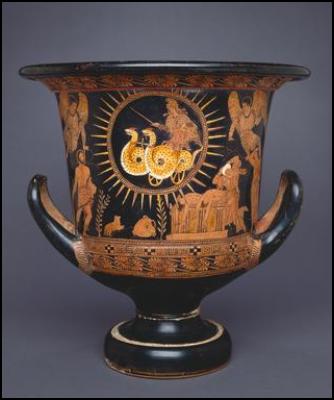
Cleveland Museum of Art - Lucanian Calyx-Krater
Cleveland Museum's antiquities officials have failed to respond to my email request for information as to how the museum acquired the South Italian Medea vase in 1991 recently cited on this page Cleveland's Got Prized South Italian Medea Vase. The vase was part of a highly controversial auction of the Hunt brothers' collection at Sotheby's in June 1990. However, an informed source close to the Italian investigation advises that Italy will pursue the Medea along with other pieces now in Cleveland's collection of ancient art.
The Medea is believed to have been sold to former Rodeo Drive dealer, Bruce McNall, by Bob Hecht. McNall has written in his book, Fun While It Lasted, that he got virtually every piece he sold to Bunker and Herbert Hunt from Hecht. Hecht's principal supplier was Giacomo Medici.
Hecht, is on trial in Rome charged with being part of a conspiracy to traffic in ancient art; Giacomo Medici is appealing a10-year sentence this month in Rome for antiquities trafficking.
The Italians already list #82 -- a "Lekythos attica a figure nere, oggi al Museo di Cleveland" as one of the 94 pieces Hecht trafficked. This seems to be the oil flask indentified:
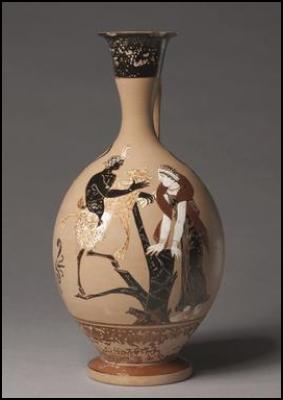
Cleveland Museum of Art - Paestan Black-Figure Lekythos (South Italy, Campania, 4th Century BC)
Another vase the Italians may want back from Cleveland is a red figure lekythos, a 1986 gift to the museum from Hecht's former financier at Atlantis Antiquiites Gallery, Jonathan Rosen.
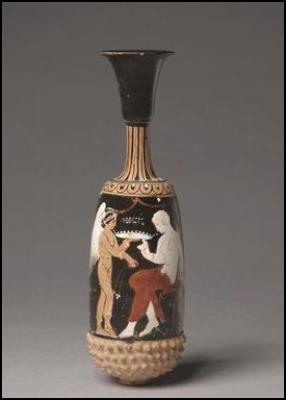
Cleveland Museum of Art - Campanian Red-Figure Acorn Lekythos (South Italy, Campania, 4th Century BC
And maybe this krater:
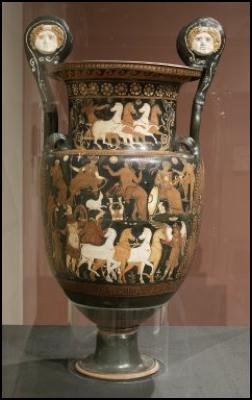
Cleveland Museum of Art - Apulian Volute-Krater (Darius Painter)
…and this one too:

Cleveland Museum of Art - Apulian Bell-Krater (South Italy Apulia, 4th Century BC)
Cleveland Museum, essentially closed for expansion, has in recent years been under a cloud for its acquisition of the bronze Apollo "Lizard Slayer" (400 BC - 330 BC), a statue produced in Praxiteles' workshop which somehow made its way to Ali and Hisham Aboutaam's Phoenix Ancient Art Gallery, where Cleveland bought it. The museum says the statue came from an old collection in Germany, but Greece believes it is theirs.
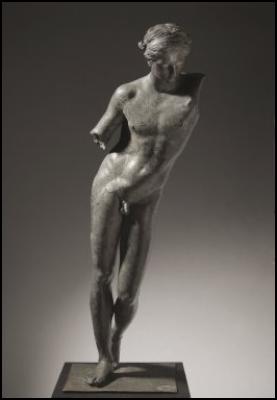
Cleveland Museum of Art - Apollo Sauroktonos (Lizard-Slayer)
The Aboutaams are exhibiting a collection of 6th c-4th c BC Greek vases next week, which should also prove interesting: "The Painter's Eye: The Art of Greek Ceramics. Greek Vases from a Swiss Private Collection and other European Private Collections." [See also... PRNewswire: Phoenix Ancient Art to Premiere Important Collection of Greek Vases at Its New York City Gallery]
A collection of early Christian marbles acquired by Cleveland in the 1960s -- the Jonah Marbles -- believed by Byzantine scholar Donal McColl and others to be some of the most important early Christian pieces, pre-Constantinian, to have survived -- have long been claimed by the Turks as looted from Afyon.

Turkish journalist, Ozgen Acar, agrees that the pieces are genuine (marble from the Dokimian quarry in Phrygia) and says he's got eight files on the Jonah marbles sold to Cleveland through Turkish dealer Aydin Dikmen [ See also… Scoop: Getting To The Bottom Of The Dorak Affair ]. Dikmen spent a year in jail in Germany in the late 1990s for hoarding looted antiquities inside the walls of his Munich apartment -- a treasure the likes of which the Bavarian police said they hadn't seen since the cache of Nazi loot discovered following WWII.
Dikmen also produced a "menagerie" of miniature animals resembling a collection Cleveland exhibited in the 1980s from the late Swiss collector Leo Mildenberg [See also… Scoop: Merrin Gallery in Italy's Antiquities Dragnet?].
Cleveland's longtime curator of ancient art, Arielle Kozloff -- on whose watch the above South Italian vases were acquired -- described the animal miniatures in her 1981 book, Animals in Ancient Art from the Leo Mildenberg Collection, as 4th millennium BC -- made by an unknown culture, ancestors of the Urartians. However, Met Ancient Near East expert Oscar Muscarella and other scholars have commented that the Urartians lived in the 8th century BC (north of Lake Van in present day Turkey).
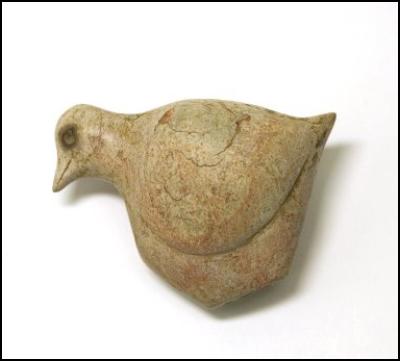
Cleveland Museum of Art - Nesting Quail Stamp Seal
Kozloff left the Cleveland Museum after 20 years to work with New York art dealer Ed Merrin, who coincidentally, also had an exhibition of and sold ($1,000@) his Anatolian "miniature masterpieces" in 1982. [ See also… Scoop: Ancient Art Italy Wants Back From Boston's MFA]
Kozloff has now also left Merrin's employ and works as an "independent scholar", although it is unclear just where.
Ironically, it was former Cleveland curator of ancient art, John D. Cooney, in 1970, around the time of the "Pennyslvania declaration" on museum ethics and the UNESCO treaty banning the purchase of looted art, who was out in front announcing that 95% of all ancient art in America's museums was smuggled. Unfortunately, Cooney was the first and the last so far of Cleveland's ancient art curators to stand tall.
 Suzan
Mazur's stories on art and antiquities have been published
in The Economist, Financial Times, Connoisseur, Archaeology
(cover) and Newsday. Some of her other reports have
appeared on PBS, CBC and MBC. She has been a guest on
McLaughlin, Charlie Rose and various Fox television news
programs. Email:
sznmzr@aol.com
Suzan
Mazur's stories on art and antiquities have been published
in The Economist, Financial Times, Connoisseur, Archaeology
(cover) and Newsday. Some of her other reports have
appeared on PBS, CBC and MBC. She has been a guest on
McLaughlin, Charlie Rose and various Fox television news
programs. Email:
sznmzr@aol.com


 Peter Dunne: Dunne's Weekly - Trump's Tariffs Still Pose Risks For New Zealand
Peter Dunne: Dunne's Weekly - Trump's Tariffs Still Pose Risks For New Zealand Keith Rankin: Barbecued Hamburgers And Churchill's Bestie
Keith Rankin: Barbecued Hamburgers And Churchill's Bestie Gordon Campbell: On Why The US Stands To Lose The Tariff Wars
Gordon Campbell: On Why The US Stands To Lose The Tariff Wars Eugene Doyle: Before It’s Too Late - Reimagine New Zealand’s Military Future
Eugene Doyle: Before It’s Too Late - Reimagine New Zealand’s Military Future  Binoy Kampmark: Gender Stunts In Space - Blue Origin’s Female Celebrity Envoys
Binoy Kampmark: Gender Stunts In Space - Blue Origin’s Female Celebrity Envoys Richard S. Ehrlich: A Deadly Earthquake & Chinese Construction
Richard S. Ehrlich: A Deadly Earthquake & Chinese Construction